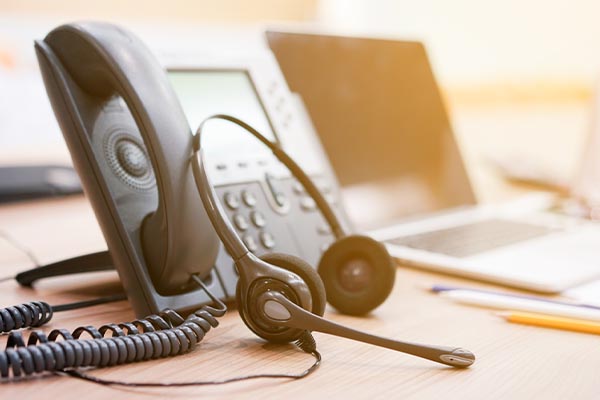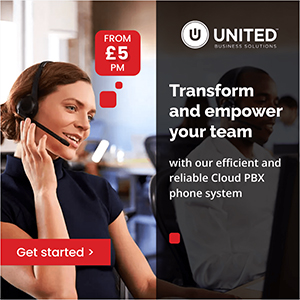Blog, VoIP & Hosted PBX
How to port landline numbers to VoIP in the United Kingdom in 2023
As the 2025 deadline for the switch from Public Switched Telephone Network (PSTN) and Wholesale Line Rental 3 (WLR3) to Voice over Internet Protocol (VoIP) fast approaches, businesses across the United Kingdom are faced with the important task of porting their landline numbers to VoIP.
While this process comes with numerous benefits, including cost savings, increased functionality, and future-proofing your communication needs, it can also pose some challenges.
In this blog post, we will demystify the process of porting your landline number to VoIP, address potential hurdles, and provide a step-by-step guide to ensure a smooth transition. Whether you’re an industry veteran or a newcomer, this guide will help you navigate the changes and make the most of the advantages VoIP has to offer.
Table of Contents
- Introduction to VoIP and landline porting
- Why port your landline number to a VoIP provider?
- 5 steps to porting your landline number.
- Legal restrictions and obligations for losing providers
- How to avoid landline number porting being rejected and delays?
- Final thoughts on making the switch to VoIP
Introduction to VoIP and landline porting
What is VoIP?
Voice over Internet Protocol, or VoIP, is a technology that enables voice communication and multimedia sessions over an internet connection, unlike traditional landline systems which use copper lines.
What is Number Porting?
Porting is the process of transferring your existing landline number to a VoIP service provider, thus keeping the same number while benefiting from the features and cost-effectiveness of VoIP.
How much does number porting cost in the UK?
The cost of number porting in the UK can vary among providers. Fortunately, United Telecoms does not charge for number porting. However, some providers may charge between £5.00 and £10 per number. It’s important to check with your provider for pricing.
Which numbers can be ported over to VoIP?
In general, most numbers can be ported over to VoIP, including geographic numbers and non-geographic numbers. However, there may be rare cases where certain special numbers cannot be ported. It’s best to consult with your VoIP service provider to confirm the portability of your specific number.
What is PSTN?
Public Switched Telephone Network (PSTN) is a global network consisting of interconnected voice-oriented public telephone networks. It represents the traditional circuit-switched telephone system and is operated by various carriers at local, national, and international levels.
The PSTN infrastructure and services enable public telecommunication, facilitating voice communication across the world. It forms the backbone of traditional landline telephone services and has been the primary means of voice communication for many years.
What is WLR3?
Wholesale Line Rental 3 (WLR3) is a service that allows alternative telecom providers to take control of telephone line connections from the native operator. By purchasing a wholesale product from the incumbent operator, WLR3 providers can offer a single bill to subscribers, covering both calls and line rental.
Additionally, broadband services can be included in the WLR3 package if a separate wholesale DSL product is obtained. This service enables telecom providers to offer comprehensive and consolidated billing options to end users, simplifying the payment process and potentially offering bundled services for greater convenience.
When are WLR3 and PSTN being switched off?
With the imminent phasing out of the PSTN and WLR3 in the UK by 2025, the switch to VoIP is not just beneficial but necessary for businesses.
The end of PSTN and WLR3 means the discontinuation of copper-based, traditional landline services, hence, porting landline numbers to a VoIP provider is a critical step to ensure uninterrupted business communication. This transition, while significant, is made easier with careful planning and understanding of the process.

Why port your landline number to a VoIP provider?
Porting your existing phone number to VoIP holds several advantages.
One of the key reasons is maintaining brand recognition and continuity for your customer base. The number that your customers have used to reach you for years can still be in service, providing a seamless transition with minimal disruption.
Additionally, switching to VoIP offers numerous benefits. It’s generally more cost effective than traditional landline services, often offering lower call rates and reduced setup and maintenance costs. VoIP serves as the underlying technology of your Hosted or Hybrid PBX phone system facilitating voice calls via your internet connection.
Moreover, VoIP is future-proof. With the discontinuation of the PSTN and WLR3 in 2025, VoIP stands as the future of business communications. Porting your landline number to VoIP ensures your business is prepared for this inevitable shift.
5 steps to porting your landline number to a VOIP service provider.
At United Telecoms, we have extensive experience in successfully porting business numbers to VoIP lines. Our team takes care of the entire process, ensuring a seamless and efficient transition.
Before porting your number we need to establish if there is a current broadband connection associated with this number, in this event, we would install a new line (internet connection) to ensure a smooth transition and minimise downtime.
Below, we have simplified the steps required to port your landline numbers to VoIP. If you need further assistance or have any questions, feel free to reach out to us via email at info@united-telecoms.co.uk or give us a call at 020 3399 8011.
Follow these steps and don’t hesitate to contact us for additional support.

1. Determining your needs: keeping or changing your number?
Before embarking on the porting process, it’s important to determine whether to keep your existing landline number or opt for a new one.
While acquiring a new number could signal a fresh start, retaining your current one offers continuity, especially if it’s been associated with your business for a long time.
When porting to United Telecom’s VoIP service, our representatives may inquire about the primary purpose of your current line and the duration of usage of your current number to assess its significance to your operations and brand image.
Other considerations include your customer’s familiarity with your existing number and the potential implications on your marketing materials. Remember, the objective of porting to VoIP is to enhance your communication framework, not to cause confusion among your clients or stakeholders.
Making an informed decision at this step is crucial for a smooth transition to VoIP.
2. Ensure you have active account with your landline service provider
Having an active account with your current landline service provider is essential when you transfer landline number to VoIP. The process hinges on the transfer of your existing number from one service provider to another, which cannot be done if your account is inactive or suspended.
Remember to check the active status of your account and resolve any potential issues with your old provider as these are prerequisites to a smooth VoIP porting experience.
Learn more about how to avoid landline number porting being rejected and delays below.

3. Submit required documents to start the number porting process
Once you’ve determined your needs and ensured your account is active, the next step is to submit the necessary documents to your new service provider to start the porting process. These include:
- Your Access Line ID (AL ID),
- a current invoice from your service provider,
- a letter of authority
Remember, to initiate the porting process, place an order with your chosen VoIP provider, e.g. United Telecoms, providing them with these details and any additional information they may require. This process ensures a smooth transition to your new VoIP service. You may also contact your current landline provider to confirm that all your account details on their side are correct and to ensure they are aware of your intention to port your number..
AL ID and invoice
Your AL ID is a unique identifier for your landline (found either on your invoice or from a quick call to your current provider’s customer support). This, along with your current invoice, proves your ownership of the number and shows your account is active and eligible for porting.
LOA – Letter of authority
If you are migrating from WLR3 to VoIP (and in most other porting cases), you’ll need a Letter of Authority (LOA). This authorises the new provider, in this case United Telecoms, to take over the number. You can download our LOA template here to fill in your details.
An LOA isn’t required for analogue to analogue or WLR to WLR migrations as the processes are less complex. Remember to include a copy of the ID of the signatory making the request on behalf of your company.

4. Lead time and cancellations
After submitting all the necessary documents to your new service provider, it typically takes between 10-14 days from when your VoIP provider places the order on their side for the porting process to be completed.
This is the standard lead time, although it can sometimes vary depending on the complexities involved. It’s crucial to be aware of this to manage expectations and plan any necessary business operations accordingly.
Cancellation of porting request
During this period, you have the option to cancel the porting request if you change your mind or your circumstances alter. However, make sure to inform your new service provider as soon as possible to avoid any potential complications.
5. Start using your VoIP setup and cancel landline services
Once the porting process is complete and your new VoIP service is active, it’s time to start using your new VoIP connection to manage your communications.
As for your landline service, it’s crucial to wait until your number has been successfully ported to your VoIP service before cancelling. Doing so prematurely could result in losing your number entirely. Once the port is confirmed, reach out to your former landline provider to terminate the service.
Legal restrictions and obligations for losing providers
While making the switch to VoIP, it’s essential to understand your rights and the obligations of your current, or “losing,” provider.
According to Ofcom regulations, your existing provider cannot hinder or stop the porting process due to any outstanding payments or termination fees you might have. This protection ensures that customers can freely switch services without being held hostage by past dues.
However, it’s crucial to know that this doesn’t absolve you of any financial obligations you have with your current provider. They are required to notify you about any outstanding charges or termination fees, which you’ll need to settle even after porting your number to VoIP.
Balancing your obligations while taking advantage of the benefits VoIP offers will help facilitate a smooth and cost-effective transition.

How to avoid landline number porting being rejected and delays?
Navigating the VoIP porting process can be a smooth sail when you’re well-prepared.
In this section, we’ll delve into the proactive measures you can take to sidestep potential rejections and delays during the porting process. Let’s ensure your switch to VoIP is as seamless and prompt as possible.
Cancellation of services with current provider before porting
When porting your current landline number to VoIP, timing is crucial. A common mistake is cancelling your existing service before completing the porting process, which can lead to losing your phone number entirely.
It’s essential to maintain active service with your current provider until you receive notification that the porting process to your VoIP service is successful. Only then should you contact your current provider to cancel the service.
If you don’t own the number you are trying to port
Ownership is a critical factor in porting landline numbers to VoIP. Without legal rights to the number you’re trying to port, you will inevitably encounter roadblocks.
Essentially, the number must be registered in your name or your business’s name. To confirm ownership, check your service agreement or directly contact your current provider. If there are any discrepancies, you’ll need to resolve them before you can port the number.
Other reasons VoIP number porting can be rejected:
There are several other reasons why your VoIP number port request may be rejected:
- The number or number range is not valid on your existing service provider’s network, or is not exclusively used by the entity requesting the port.
- The account number provided doesn’t match the one used by your current provider for the number or number range you’re trying to port.
- The number or number range is already subject to another porting process. You can’t initiate a new process until the existing one is completed.
- The number or number range has already been ported within the last two months. Regulations require a minimum gap between porting processes to avoid conflicts and confusion.

Final thoughts on making the switch to VoIP
In conclusion, porting your landline number to VoIP offers numerous benefits such as cost savings, access to advanced features, and future-proofing your communication system. While there may be challenges along the way, the advantages far outweigh them.
It’s crucial to make the switch before the 2025 PSTN shut-off to ensure uninterrupted service and compliance with changing telecommunications infrastructure.
If you’re considering porting your landline number to VoIP, don’t hesitate to contact United Telecoms. Our friendly specialists are ready to assist you every step of the way, from determining your needs to submitting the necessary documents and navigating the porting process. Contact us today and experience the seamless transition to VoIP, unlocking a world of enhanced communication possibilities.







Got questions? Contact our experts today.
We service the following locations across London and the United Kingdom
Greater London: City of London, Hounslow, Barking and Dagenham, Islington, Barnet, Kensington and Chelsea, Bexley, Kingston upon Thames, Brent, Lambeth, Bromley, Lewisham, Camden, Merton Croydon, Newham, Ealing, Redbridge, Enfield, Richmond upon Thames, Greenwich, Southwark, Hackney, Sutton, Hammersmith and Fulham, Tower Hamlets, Haringey, Waltham Forest, Harrow, Wandsworth, Havering, Westminster and Hillingdon.
What Our Customers Say
“Once we approved the installations we were kept up to date daily with the levels of progress on our various sites and were very impressed with the final installation”
Spear Properties
Get In Touch
London Office
2 Osborne Way
Epsom
Surrey
KT19 8GR
United Kingdom (UK)
Tel: 033 1630 0516
Tel: 020 3399 8011
Email: info@united-telecoms.co.uk
We're the experts so that you don't need to be!
PBX Phone System
Beginner's Guide
Voice & Hosted PBX
Resources
PABX Relocation and
Reinstallation
PBX Phone System
Resources